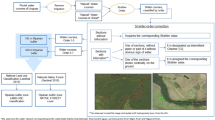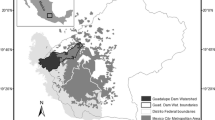Abstract
Riparian ecosystems are interfaces between aquatic and terrestrial environments recognized for their nutrient interception potential in agricultural landscapes. Stream network maps from a broad range of map resolutions have been employed in watershed studies of riparian areas. However, map resolution may affect important attributes of riparian buffers, such as the connectivity between source lands and small stream channels missing in coarse resolution maps. We sought to understand the influence of changing stream map resolution on measures of the river network, near-stream land cover, and riparian metrics. Our objectives were: (1) to evaluate the influence of stream map resolution on measures of the stream network, the character and extent of near-stream zones, and riparian metrics; (2) to compare patterns of variation among different physiographic provinces; and (3) to explore how predictions of nutrient retention potential might be affected by the resolution of a stream map. We found that using fine resolution stream maps significantly increased our estimates of stream order, drainage density, and the proportion of watershed area occurring near a stream. Increasing stream map resolution reduced the mean distance to source areas as well as mean buffer width and increased the frequency of buffer gaps. Measures of percent land cover within 100 m of streams were less sensitive to stream map resolution. Overall, increasing stream map resolution led to reduced estimates of nutrient retention potential in riparian buffers. In some watersheds, switching from a coarse resolution to a fine resolution stream map completely changed our perception of a stream network from well buffered to largely unbuffered. Because previous, broad-scale analyses of riparian buffers used coarse-resolution stream maps, those studies may have overestimated landscape-level buffer prevalence and effectiveness. We present a case study of three watersheds to demonstrate that interactions among stream map resolution and land cover patterns make a dramatic difference in the perceived ability of riparian buffers to ameliorate effects of agricultural activities across whole watersheds. Moreover, stream map resolution affects inferences about whether retention occurs in streams or riparian zones.






Similar content being viewed by others
References
Alexander RB, Smith RA, Schwarz GE (2000) Effect of stream channel size on the delivery of nitrogen to the Gulf of Mexico. Nature 403:758–761
Baker ME, Weller DE, Jordan TE (2006a) Improved methods for quantifying potential nutrient interception by riparian buffers. Landscape Ecol 21:1327–1345
Baker ME, Weller DE, Jordan TE (2006b) Comparison of automated watershed delineations: effects on land cover areas, percentages, and relationships to nutrient discharge. Photogram Eng Remote Sens 72(2):159–168
Boesch DF, Brinsfield RB, Magnien RE (2001) Chesapeake Bay eutrophication: scientific understanding, ecosystem restoration, and challenges for agriculture. J Environ Qual 30:303–320
Bren LJ (2000) A case study in the use of threshold measures of hydrologic loading in the design of stream buffer strips. Forest Ecol Manage 132:243–257
Carpenter S, Caraco NF, Correll DL, Howarth RW, Sharpley AN, Smith VH (1998) Nonpoint pollution of surface waters with phosphorus and nitrogen. Ecol Appl 8:559–568
Correll DL, Jordan TE, Weller DE (1997) Failure of agricultural riparian buffers to protect surface waters from groundwater nitrate contamination. In: Gibert J Mathieu J Fournier F (eds) Groundwater/surface water ecotones: biological and hydrological interactions and management options. Cambridge University Press, Cambridge, UK, pp 162–165
Dosskey MG (2001) Toward quantifying water pollution abatement in response to installing buffers on crop land. Environ Manage 28:577–598
Dosskey MG, Helmers MJ, Eisenhauer DE, Franti TG, Hoagland KD (2002) Assessment of concentrated flow through riparian buffers. J Soil Water Conserv 57(6):336–343
Dosskey MG, Eisenhauer DE, Helmers MJ (2005) Establishing conservation buffers using precision information. J Soil Water Conserv 60(6):349–354
Fisher SG, Welter JR (2005) Flowpaths as integrators of heterogeneity in streams and landscapes. Chapter 15. In: Lovett GM, Jones CG, Turner MG, Weathers KC (eds) Ecosystem function in heterogeneous landscapes. Springer Press, New York
Gold AJ, Groffman PM, Addy K, Kellogg DQ, Stolt M, Rosenblatt AE (2001) Landscape attributes as controls on groundwater nitrate removal capacity of riparian zones. J Am Water Resour Assoc 37:1457–1464
Hancock GR, Evans KG (2006) Channel head location and characertistics using digital elevation models. Earth Surface Process Landforms 31:809–824
Hassett B, Palmer MA, Bernhardt ES, Smith S, Carr J, Hart DD (2005) Restoring watersheds project by project: trends in Chesapeake Bay tributary restoration. Front Ecol Environ 3(5):259–267
Hellweger FL (1997) AGREE – DEM Surface Reconditioning System. URL: http://www.ce.utexas.edu/prof/maidment/gishydro/ferdi/research/agree/agree.html, University of Texas, Austin, (last date accessed: 29 April 2006)
Hill AR (1996) Nitrate removal in stream riparian zones. J Environ Qual 25:743–755
Hollenhorst TH, Host GE, Johnson LB (2006) Scaling issues in mapping riparian zones with remote sensing data: quantifying errors and sources of uncertainty. Chapter 15. In: Wu J, Jones KB, Li H, Loucks O (eds) Scaling and uncertainty analysis in ecology: methods and applications. Springer, Netherlands, pp 275–295
Jenson SK, Domingue JO (1988) Extracting topographic structure from digital elevation data for geographic information system analysis. Photogram Eng Remote Sens 54(11):1593–1600
Johnson LB, Richards C, Host GE, Arthur JW (1997) Landscape influences on water chemistry in Midwestern stream ecosystems. Freshwater Biol 37:193–208
Jones KB, Neale AC, Nash MS, Van Remortel RD, Wickham JD, Riiters KH, O’Neill RV (2001) Predicting nutrient discharges and sediment loadings to streams from landscape metrics: a multiple watershed study from the United States Mid-Atlantic Region. Landscape Ecol 16:301–312
Jordan TE, Weller DE (1996) Human contributions to terrestrial nitrogen flux. Bioscience 46:655–664
Jordan TE, Correll DL, Weller DE (1993) Nutrient interception by a riparian forest receiving cropland runoff. J Environ Qual 22:467–473
Jordan TE, Correll DL, Weller DE (1997a) Effects of agriculture on discharges of nutrients from Coastal Plain watersheds of Chesapeake Bay. J Environ Qual 26(3):836–848
Jordan TE, Correll DL, Weller DE (1997b) Nonpoint source discharges of nutrient from Piedmont watersheds of Chesapeake Bay. J Am Water Resour Assoc 33(3):631–645
Jordan TE, Weller DE, Correll DL (2003) Sources of nutrient inputs to the Patuxent River estuary. Estuaries 26:226–243
King RS, Richardson CJ (2003) Integrating bioassessment and ecological risk assessment: an approach to developing numerical water-quality criteria. Environ Manage 31:795–809
King RS, Baker ME, Whigham DF, Weller DE, Jordan TE, Kazyak PF, Hurd MK (2005) Spatial considerations for linking watershed land cover to ecological indicators in streams. Ecol Appl 51(1):137–152
Langland MJ, Lietman PL, Hoffman S (1995) Synthesis of nutrient and sediment data for watersheds within the Chesapeake Drainage Basin. US Geological Survey Water Resources Investigations Report 95–4233. Lemoyne, Pennsylvania
Liu Z-J, Weller DE, Correll DL, Jordan TE (2000) Effects of land cover and geology on stream chemistry in watersheds of Chesapeake Bay. J Am Water Resour Assoc 36(6):1349–1365
Lowrance RR, Altier LS, Newbold JD, Schnabel RR, Groffman PM, Denver JM, Correll DL, Gilliam JW, Robinson JL, Brinsfield RB, Staver KW, Lucas W, To AH (1997) Water quality functions of riparian forest buffers in Chesapeake Bay watersheds. Environ Manage 21:687–712
McGlynn BL, Seibert J (2003) Distributed assessment of contributing area and riparian buffering along stream networks. Water Resour Res 39(4):1082
Montgomery DR, Dietrich WE (1988) Where do channels begin? Nature 336:232–234
Mulholland PJ, Valett HM, Webster JR, Thomas SA, Hamilton SK, Peterson BJ (2004) Stream denitrification and total nitrate uptake rates measured using a field 15N tracer addition approach. Limnol Oceanogr 49:809–820
O’Callaghan JF, Mark DM (1984) The extraction of drainage networks from digital elevation data. Comput Vision Graph Image Process 28:323–344
Osborne LL, Wiley MJ (1988) Empirical relationships between land use/cover and stream water quality in an agricultural watershed. J Environ Manage 26:9–27
Osborne LL, Kovacic DA (1993) Riparian vegetated buffer strips in water-quality restoration and stream management. Freshwater Biol 29:243–258
Peterjohn WT, Correll DL (1984) Nutrient dynamics in an agricultural watershed: observations on the role of a riparian forest. Ecology 65:1466–1475
Peterson BJ, Wolheim WM, Mulholland PJ, Webster JR, Meyer JL, Tank JL, Marti E, Bowden WB, Valett HM, Hershey AE, McDowell WH, Dodds WK, Hamilton SK, Gregory S, Morrall DD (2001) Control of nitrogen export from watersheds by headwater streams. Science 292:86–90
Polyakov V, Fares A, Ryder MH (2005) Precision riparian buffers for the control of nonpoint source pollutant loading into surface water: a review. Environ Rev 13:129–144
Qian SS, King RS, Richardson CJ (2003) Two statistical methods for the detection of environmental thresholds. Ecol Model 166:87–97
Rabalais NN, Turner RE, Wiseman WJ (2001) Hypoxia in the Gulf of Mexico. J Environ Qual 30:320–329
Roth NE, Allan JD, Erickson DL (1996) Landscape influences on stream biotic integrity assessed at multiple spatial scales. Landscape Ecol 11:141–156
Royer TV, Tank JL, David MB (2004) Transport and fate of nitrate in headwater agricultural streams in Illinois. J Environ Qual 33:1296–1304
Saunders WK (2000) Preparation of DEMs for use in environmental modeling analysis. Chapter 2. In: Maidment D, Djokic D (eds) Hydrologic and hydraulic modeling support with geographic information systems. Environmental Systems Research Institute, Inc., Redlands, California, pp 29–51
Seitzinger SP, Styles RV, Boyer EW, Alexander RB, Billen G, Howarth R, Mayer B, van Breemen N (2002) Nitrogen retention in rivers: model development and application to watersheds in the northeastern. USA Biogeochem 57:199–237
Sokal RR, Rolf FJ (1995) Biometry, 3rd edn. WH Freeman. New York. 880 pp
Smith RA, Schwarz GE, Alexander RB (1997) Regional interpretation of water quality monitoring data. Water Resour Res 33:2781–2798
Stanley EH, Fisher SG, Grimm NB (1997) Ecosystem expansion and contraction in streams. BioScience 47:427–436
Strahler AN (1964) Quantitative geomorphology of drainage basins and channel networks. In: Chow VT (ed) Handbook of applied hydrology. McGraw Hill, New York
Tomer MD, James DE, Isenhart TM (2003) Optimizing the placement of riparian practices in watershed using terrain analysis. J Soil Water Conserv 58:198–206
United States Environmental Protection Agency (USEPA) (2000) Multi-Resolution Land Characteristics Consortium (MRLC) database. URL: http://www.epa.gov/mrlcpage (last date accessed: 24 February 2004)
Vidon PGF, Hill AR (2004) Landscape controls on nitrate removal in stream riparian zones. Water Resour Res 40:W03201
Vogelmann JE, Sohl T, Howard SM (1998a) Regional characterization of land cover using multiple sources of data. Photogram Eng Remote Sens 64:45–67
Vogelmann JE, Sohl T, Howard SM, Shaw DM (1998b) Regional land cover characterization using Landsat Thematic Mapper data and ancillary data sources. Environ Monitor Assess 51:415–428
Walker JP, Willgoose GR (1999) On the effect of digital elevation model accuracy on hydrology and geomorphology. Water Resour Res 35(7):2259–2268
Weller CM, Watzin MC, Wang D. (1996) Role of wetlands in reducing phosphorus loading to surface water in eight watersheds in the Lake Champlain Basin. Environ Manage 20:731–730
Weller DE, Jordan TE, Correll DL (1998) Heuristic models for material discharge from landscapes with riparian buffers. Ecol Appl 8:1156–1169
Weller DE, Jordan TE, Correll DL, Z-J Liu. (2003) Effects of land use change on nutrient discharges from the Patuxent River watershed. Estuaries 26:244–266
Wondzell SM, Swanson FJ (1996) Seasonal and storm dynamics of the hyporheic zone of a 4th-order mountain stream. I: Hydrologic processes. J North Am Benthol Soc 15:3–19
Acknowledgments
We thank Lucinda Johnson and three anonymous reviewers for helpful comments on an earlier draft of this manuscript. Doug Call, James Graves, Sal Orochena, and Nancy Lee helped to assemble spatial data used in the analyses. This research was funded by grants from the US Environmental Protection Agency’s Science to Achieve Results (STAR) Estuarine and Great Lakes (EaGLes) program (USEPA Agreement #R-82868401) and Watershed Classification Program (USEPA Agreement #R-831369). Although the research described in this article has been funded by the United States Environmental Protection Agency, it has not been subjected to the Agency’s required peer and policy review and therefore does not necessarily reflect the views of the Agency and no official endorsement should be inferred.
Author information
Authors and Affiliations
Corresponding author
Rights and permissions
About this article
Cite this article
Baker, M.E., Weller, D.E. & Jordan, T.E. Effects of stream map resolution on measures of riparian buffer distribution and nutrient retention potential. Landscape Ecol 22, 973–992 (2007). https://doi.org/10.1007/s10980-007-9080-z
Received:
Accepted:
Published:
Issue Date:
DOI: https://doi.org/10.1007/s10980-007-9080-z




